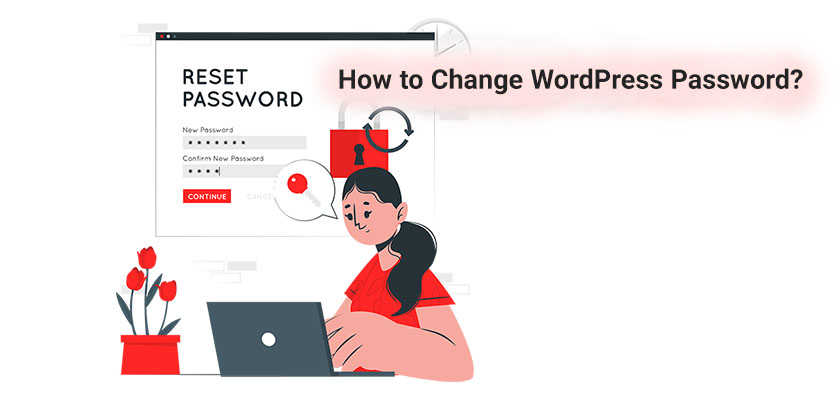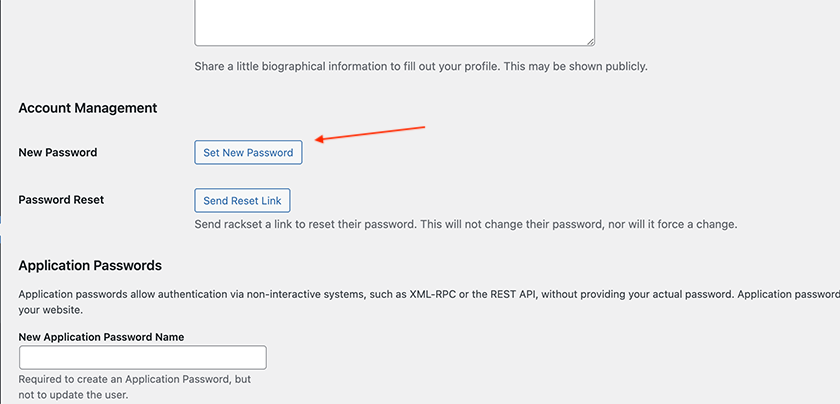
Do you want to know the best way to modify or change your WordPress password? Sometimes you’ll forget your password, or you may need to change it due to security reasons.
Although there is a link to reset your password on the log-in page, which allows you to change your password, often your WordPress account reset emails don’t make it into your inbox due to the fact that the WordPress hosting company doesn’t have it properly configured.
We at Rackset make your WordPress web hosting services much secure that nothing can threaten it buy pay attention that you have to secure all aspects of your WordPress website in order not to need to request for a backup file.
Sometimes, you might be tempted to change the WordPress passwords for each user of your site for security reasons.
Why Do You Need to Change a WordPress Password?
We cannot stress enough that passwords are the first security measure against attempts to hack a WordPress website. If you look at the most commonly used passwords in 2022, you may find your password on that list. Most of the time, users use an insecure password due to it being simple to forget. Don’t do it. You can make use of one of the numerous free and secure password management tools that you can use to both generate a secure password and save them.
Sometimes, it can be tempting to give WordPress passwords to colleagues or even SEO agencies. Avoid doing that. Instead, we suggest setting up a new user account with the appropriate user role so that you are able to manage the permissions.
You can then easily erase their account once they’re no longer working with you at any given time. But how can you change WordPress password if you simply have forgotten it?
How to Use WordPress Reset Password?
What happens if you forget your WordPress admin password? How can you enter the WordPress dashboard? Don’t panic. Losing or forgetting your WordPress admin panel is not uncommon, and there are a few methods you can follow in order to change the password of your WordPress admin.
You can simply go to the WordPress login page (which is typically /wp-login.php or wp-admin.php) and click on the ‘Lost your password?’ link.
When you click on the link after that, it will redirect you to the a for WordPress reset password. You will need to enter either your email or username to reset your password for your account.
After that, WordPress will send a password reset link to your email address that is associated with your account.
How to Change Password on the WordPress Dashboard

If you are able to remember your password but want to change it, or maybe you want to manually change a user’s password, you are able to do this on your WordPress dashboard. Simply follow the steps below:
- Log in to the admin WordPress account.
- In the dashboard, choose Users, then “All Users.”.
- Hover over the user’s password that you wish to change and then click to edit.
- Go to Account Management. Click the Create New Password option.
- WordPress will automatically create a secure password for you to use. You can save it or change it to another password.
- When you’re done, hit update at the lower right of your screen. The page will refresh, and you’ll be greeted with an acknowledgment message that indicates the profile has been updated.
There’s no reason to log out and then log into your account using this method. However, if you’d like to confirm that your password was reset successfully, then you should sign out and then log in to your existing account.
WordPress Change Password in Database
The “Lost Password” method is a good one for beginners, but you might not be able to utilize that method when the account doesn’t belong to the email address that is associated with the account or if the WordPress website fails to send an email.
If this situation occurs and you need to reset your WordPress password directly within the database. The most efficient method to accomplish this is using phpMyAdmin.
The first step is to sign in with the WordPress hosting control panel. The login credentials have probably been sent to your email once you buy WordPress hosting. Once you are in the control panel, you need to click the phpMyAdmin option located under the Databases section.
When you open the phpMyAdmin app, you’ll be able to see the list of your databases. It is important to choose the database that is associated with your WordPress website.
Then, you’ll find the list of tables that are in the WordPress database. It is necessary to locate the table wp_users in the list and then click ‘Browse’ below it.
This will display an overview of all users who are registered on your WordPress website. From this screen, you have to click on the Edit button next to your account or the account you wish to edit.
phpMyAdmin will display a window with all the necessary information about the user.
It is necessary to remove the password value from the user_pass section and replace it with the new password. In the column for function, ensure that you choose MD5 in the dropdown menu and then press the “Go” button.
And that’s how you would change the password from WordPress phpMyAdmin.
How to Change WordPress Admin Password from cPanel
As mentioned above, once you buy WordPress web hosting from any hosting provider, you’ll get the necessary credentials to log into your cPanel. So, enter your cPanel with the given username and password, and you should be able to change the WordPress admin password in cPanel. Simply by locating the Application section or using WordPress, change the WordPress password in the database method that we mentioned above.
How to Change the WordPress Administrator Password
The following steps can only be used only if you’re an administrator user and you want to modify the password of the admin in particular. There are many modifications available once you have a WordPress hosting account. One of which can be used to change the admin password. Again, there are many methods to change the WordPress admin password from cPanel, like the ones we mentioned above, but in this method, we are going to use FTP to change a WordPress admin password.
Changing WordPress Password with FTP
If you wish to reset your WordPress password or simply set the WordPress password for a user, it is necessary to be able to access the administrator username and the FTP client on your PC. FTP lets you transfer your password and files directly from the computer into your WordPress hosting account via a secure connection.
You are going to need to use FileZilla, which is the most popular FTP software, and it’s free to use.
-
- Log into your website via FileZilla.
- On the left side of the screen, go to your public_html folder.
- Open your wp-content folder.
- Open your themes folder, then the folder with the active theme’s name.
- Locate the functions.php file in your active theme’s folder, and then download it.
- Paste and copy the following code line right at the start of the functions.php file, which was created after the first
- Replace “password” within the parentheses with your new administrator password. Keep the “1” as is. “1” is “1” that represents the user ID number that is stored in the table wp_users in the table in your MySQL database. (We have covered WordPress reset admin password in SQL)
- Upload the modified file to your website.
- Log into your site using the new password you have created.
- Once you’ve logged in successfully, you can go back and remove the part of the code you’ve added to the functions.php file. In the event that you do not, your password resets each time you load a page.
Conclusion
If you have forgotten your password or need to change it in order to ensure your WordPress website is safe, there are a variety of options to change your password on WordPress. We have covered how to change a WordPress password via the lost password trick, all the way to WordPress set password in phpMyAdmin.










Leave a Reply